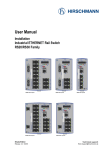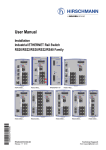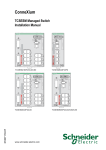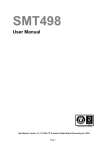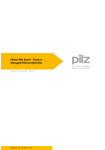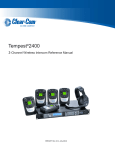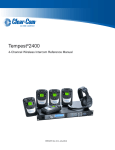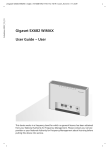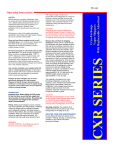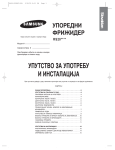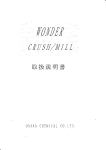Download User Manual RS20/RS30-...U Family (unmanaged - e
Transcript
User Manual Installation Industrial ETHERNET Rail Switch RS20/RS30-...U Family (unmanaged) RS20 FAULT +24V(P1) 0V 0V RS30 FAULT +24V(P1) +24V(P2) 0V 0V +24V(P2) 3 4 LS LS P DA 5 6 1 LA learn SW2 P 1 ON 7 8 LS LA learn SW2 FAULT ON DA 1 9 10 LS 11 12 LS DA FAULT DA 3 4 1 DA 13 14 19 20 LS 2 15 16 5 6 11 12 7 8 13 14 9 10 15 16 DA 21 22 1 17 18 RS20 FAULT +24V(P1) LS 0V 23 24 0V +24V(P1) LS DA P LA learn SW2 1 FAULT RS30 FAULT +24V(P2) 0V P 1 5 6 ON 0V DA LA learn SW2 FAULT LS DA 0V 0V P LA learn SW2 ON 7 8 LS RS30 FAULT +24V(P1) +24V(P2) +24V(P2) 3 4 FAULT ON 1 DA 9 10 1 LS DA 1 3 4 11 12 19 20 13 14 21 22 15 16 23 24 LS 5 6 2 RS20/RS30-...U Release 16 09/10 LS DA 5 6 7 8 2 DA 7 8 3 4 17 18 25 26 9 10 Technical Support [email protected] The naming of copyrighted trademarks in this manual, even when not specially indicated, should not be taken to mean that these names may be considered as free in the sense of the trademark and tradename protection law and hence that they may be freely used by anyone. © 2010 Hirschmann Automation and Control GmbH Manuals and software are protected by copyright. All rights reserved. The copying, reproduction, translation, conversion into any electronic medium or machine scannable form is not permitted, either in whole or in part. An exception is the preparation of a backup copy of the software for your own use. For devices with embedded software, the end-user license agreement on the enclosed CD applies. The performance features described here are binding only if they have been expressly agreed when the contract was made. This document was produced by Hirschmann Automation and Control GmbH according to the best of the company's knowledge. Hirschmann reserves the right to change the contents of this document without prior notice. Hirschmann can give no guarantee in respect of the correctness or accuracy of the information in this document. Hirschmann can accept no responsibility for damages, resulting from the use of the network components or the associated operating software. In addition, we refer to the conditions of use specified in the license contract. You can get the latest version of this manual on the Internet at the Hirschmann product site (www.beldensolutions.com). Printed in Germany Hirschmann Automation and Control GmbH Stuttgarter Str. 45-51 72654 Neckartenzlingen Germany Tel.: +49 1805 141538 RS20/RS30-...U039 524-100-16-0910 – 17.9.10 Contents Safety instructions 4 Key 9 1 Device description 10 1.1 Description of the device variants 1.1.1 Combination options for RS20/30-...U 1.1.2 Number of ports and media for RS20...U 1.1.3 Number of ports and media for RS30...U 11 12 15 18 2 Assembly and start-up 21 2.1 Installing the device 2.1.1 Unpacking and checking 2.1.2 Installing the SFP modules (optional) 2.1.3 Adjust DIP switch settings 2.1.4 Connecting the terminal blocks for supply voltage and signal contact 2.1.5 Installing the device on the DIN rail, grounding 2.1.6 Dimension drawings 2.1.7 Installing the terminal block, start-up procedure 2.1.8 Connecting the data lines 21 21 22 22 2.2 Display elements 28 2.3 Disassembly 29 3 Technical data 30 A Further Support 37 RS20/RS30-...U Release 16 09/10 22 24 25 25 26 3 Safety instructions Notes on safety This manual contains instructions to be observed for ensuring your personal safety and for preventing damage. The warnings appear next to a warning triangle with a different heading depending on the degree of danger posed: Danger! Means that death, serious physical injury or significant damage to property will occur if the corresponding safety measures are not carried out. Warning! Means that death, serious physical injury or significant damage to property could occur if the corresponding safety measures are not carried out. Caution! Means that minor physical injury or damage to property can occur if the required safety measures are not carried out. Note: Contains important information on the product, on how to manage the product, or on the respective section of the documentation to which your special attention is being drawn. Certified usage Please observe the following: The device may only be employed for the purposes described in the catalog and technical description, and only in conjunction with external devices and components recommended or approved by the manufacturer. The product can only be operated correctly and safely if it is transported, stored, installed and assembled properly and correctly. Furthermore, it must be operated and serviced carefully. Supply voltage For safety reasons the devices have been designed to operate at low voltages. Thus, they may only be connected to the supply voltage connections and to the signal contact with SELV circuits with the voltage restrictions in accordance with IEC/EN 60950-1. The supply voltage is electrically isolated from the housing. Use undamaged parts. 4 RS20/RS30-...U Release 16 09/10 Relevant for North America: For use in Class 2 circuits. The device may only be connected to a supply voltage of class 2 that fulfills the requirements of the National Electrical Code, Table 11(b). If the voltage is being supplied redundantly (two different voltage sources), the combined supply voltages must fulfill the requirements of the National Electrical Code, Table 11(b). Relevant for North America: For use in Class 2 circuits. Only use copper wire/conductors of class 1, 75 °C (167 °F). Relevant for North America for devices certified for hazardous locations: Power, input and output (I/O) wiring must be in accordance with Class I, Division 2 wiring methods [Article 501-4(b) of the National Electrical Code, NFPA 70] and in accordance with the authority having jurisdiction. Relevant in Europe for RS20 devices and RS30 devices used in explosive gas atmospheres according to ATEX Directive 94/9 EC: Make sure that the device has the following label: II 3G Ex nA II C T4 The product must be mounted in a suitable IP 54-certified housing – tested to 4 J impact to minimize the risk of mechanical damage. For ambient temperatures below -10 °C and above +60 °C use wiring suitable for both the minimum and maximum temperatures. Connectors may be connected exclusively in dead-voltage state. DIP switches may be switched exclusively in dead-voltage state. The device does not contain any service components. Internal fuses are only triggered if there is a fault in the device. If the device is not functioning correctly, or if it is damaged, switch off the voltage supply and return the device to the plant for inspection. Only switch on the supply voltage to the device if - the housing is closed, - the terminal blocks are wired up correctly and - the terminal blocks are connected. Shielding ground Note: The shielding ground of the connectable twisted pair lines is connected to the front panel as a conductor. Beware of possible short circuits when connecting a cable section with conductive shielding braiding. Housing Warning! Never insert sharp objects (small screwdrivers, wires, etc.) into the inside of the product. There is the risk of an electric shock. RS20/RS30-...U Release 16 09/10 5 Warning! When installing the device, make sure the ventilation slots remain free, as otherwise damage can occur through overheating. Only technicians authorized by the manufacturer are permitted to open the housing. The housing is grounded via the separate ground screw on the bottom left of the front panel. The clearance to the ventilation slots of the housing must be at least 10 cm (3.94 in). The device must be installed in the vertical position. If installed in a living area or office environment, the device must be operated exclusively in switch cabinets with fire protection characteristics in accordance with EN 60950-1. Environment The device may only be operated at the specified surrounding air temperature (temperature of the ambient air at a distance of up to 5 cm (1.97 in) from the device) and relative air humidity specified in the technical data. Install the device in a location where the climatic threshold values specified in the technical data will be observed. Use the device only in an environment within the contamination level specified in the technical data. Qualification requirements for personnel Qualified personnel as understood in this manual and the warning signs, are persons who are familiar with the setup, assembly, startup, and operation of this product and are appropriately qualified for their job. This includes, for example, those persons who have been: trained or directed or authorized to switch on and off, to ground and to label power circuits and devices or systems in accordance with current safety engineering standards; trained or directed in the care and use of appropriate safety equipment in accordance with the current standards of safety engineering; trained in providing first aid. General safety instructions Electricity is used to operate this equipment. Comply with every detail of the safety requirements specified in the operating instructions regarding the voltages to apply (see page 4). 6 RS20/RS30-...U Release 16 09/10 Non-observance of these safety instructions can therefore cause material damage and/or serious injuries. Only appropriately qualified personnel should work on this device or in its vicinity. These personnel must be thoroughly familiar with all the warnings and maintenance procedures in accordance with this operating manual. The proper and safe operation of this device depends on proper handling during transport, proper storage and assembly, and conscientious operation and maintenance procedures. Never start operation with damaged components. Only use the devices in accordance with this manual. In particular, observe all warnings and safety-related information. Any work that may be required on the electrical installation may only be carried out by personnel trained for this purpose. Note: LED or LASER components in compliance with IEC 60825-1 (2001): CLASS 1 LASER PRODUCT CLASS 1 LED PRODUCT Warning Laser light Do not look into the beam or view it directly with optical instruments (e.g. magnifying glasses, microscopes). Failure to observe this warning within a distance of 100 mm can endanger your sight. Light is emitted from the optical connections or from the ends of the optical fibers that are connected to them. Light Emitting Diode CLASS 2M, wave length 650 nm, power <2 mW, according to DIN EN 60825-1:2003-10. National and international safety regulations Make sure that the electrical installation meets local or nationally applicable safety regulations. CE marking The devices comply with the regulations contained in the following European directive(s): 2004/108/EG Directive of the European Parliament and the council for standardizing the regulations of member states with regard to electromagnetic compatibility. RS20/RS30-...U Release 16 09/10 7 In accordance with the above-named EU directive(s), the EU conformity declaration will be at the disposal of the relevant authorities at the following address: Hirschmann Automation and Control GmbH Stuttgarter Str. 45-51 72654 Neckartenzlingen Tel.: +49 1805 141538 The product can be used in living areas (living area, place of business, small business) and in industrial areas. Interference immunity: EN 61000-6-2:2005 Emitted interference: EN 55022:2006 + A1:2007 Class A Warning! This is a class A device. This device can cause interference in living areas, and in this case the operator may be required to take appropriate measures. The assembly guidelines provided in these instructions must be strictly adhered to in order to observe the EMC threshold values. FCC note: This device complies with part 15 of FCC rules. Operation is subject to the following two conditions : (1) This device may not cause harmful interference; (2) this device must accept any interference received, including interference that may cause undesired operation. Appropriate testing has established that this device fulfills the requirements of a class A digital device in line with part 15 of the FCC regulations. These requirements are designed to provide sufficient protection against interference when the device is being used in a business environment. The device creates and uses high frequencies and can radiate same, and if it is not installed and used in accordance with this operating manual, it can cause radio transmission interference. The use of this device in a living area can also cause interference, and in this case the user is obliged to cover the costs of removing the interference. Recycling note After usage, this product must be disposed of properly as electronic waste, in accordance with the current disposal regulations of your county, state and country. 8 RS20/RS30-...U Release 16 09/10 Key The symbols used in this manual have the following meanings: Listing Work step Subheading RS20/RS30-...U Release 16 09/10 9 1 Device description The RS20/RS30-...U family provides you with a range of Switch variants. You can set up your device individually based on different criteria: Number of ports Transmission speed Media type Types of connectors Temperature range Certifications The RS20/RS30-...U devices are designed for the special requirements of industrial automation. They meet the relevant industry standards, provide very high operational reliability, even under extreme conditions, and also long-term reliability and flexibility. The devices allow you to set up switched industrial ETHERNET networks that conform to the IEEE 802.3 and 802.3u standards using copper wires or optical fibers in a line structure. The devices work without a fan. The voltage is supplied redundantly. The devices are mounted very quickly by snapping them onto the DIN rail. Depending on the device variant, you can choose various media to connect terminal devices and other infrastructure components: twisted pair cable multimode F/O singlemode F/O The twisted pair ports support: Autocrossing Autonegotiation Autopolarity The Hirschmann network components help you to establish continuous communication across all levels of the company. Connect your devices to: devices of the MICE family backbone devices of the MACH family the BAT wireless transmission system the EAGLE security system products for the LION control room / MACH 100 family 10 RS20/RS30-...U Release 16 09/10 1.1 Description of the device variants The devices differ with regard to the number of interfaces and the media type for connecting segments. The table below shows 2 port categories for each product variant: uplink ports and other ports. The table also shows for each product category the number of ports you can select, and the type of ports. In the column for the port type, the abbreviations F/O (optical fiber) and TP (twisted pair) indicate the media type, while the abbreviations DSC, ST, SFP and RJ45 indicate the socket type. Uplink ports Variant Numbe Type r RS20-...U 2 10/100 Mbit/s, media selectable, DSC, ST, RJ45 3 10/100 Mbit/s, media selectable, DSC, ST, RJ45 RS30-...U 2 1000 Mbit/s, media selectable, SFP, RJ45 4 2x100/1000 Mbit/s, 2x 100 Mbit/s, F/O, SFP Table 1: Other ports Number Type 6, 14, 22 10/100 Mbit/s, TP, RJ45 6, 14, 22 10/100 Mbit/s, TP, RJ45 8, 16, 24 10/100 Mbit/s, TP, RJ45 6, 14, 22 10/100 Mbit/s, TP, RJ45 Number and type of ports The devices also provide you with the following options for selecting the variant you desire: Operating temperature Certifications / declarations Standard 0 °C to +60 °C Extended -40 °C to +70 °C Extended with conformal -40 °C to +70 °C coating CE, UL508, ISA 12.12.01 (UL1604) CE, UL508, ISA 12.12.01 (UL1604), Germanischer Lloyd (GL), IEC/EN 61850-3 declaration (sub station), IEEE 1613 (sub station), EN 50121-4 railway (along track) CE, UL508, ISA 12.12.01 (UL1604), Germanischer Lloyd (GL), IEC/EN 61850-3 declaration (sub station), IEEE 1613 (sub station), EN 50121-4 railway (along track), ATEX RL 94/9 EG (hazardous location) The devices comply with the specifications of the standard(s): ISO/IEC 8802-03 10BASE-T/100BASE-TX/1000BASE-T ISO/IEC 8802-03 100BASE-FX ISO/IEC 8802-03 1000BASE-SX/LX RS20/RS30-...U Release 16 09/10 11 1.1.1 Combination options for RS20/30-...U The product designation of your device is made from combining the desired product characteristics in accordance with the following table. You will find the corresponding short designation in columns 3 and 4. 12 RS20/RS30-...U Release 16 09/10 Item Characteristic Ident. Ident.2 Property 1 to 4 Product 5 6 to 7 - (hyphen) Number of 10/100 Mbit ports RS20 RS30 08 09 16 17 24 25 00 02 T1 M2 MM b) 8 * 10/100 Mbit Ethernet 9 * 10/100 Mbit Ethernet 16 * 10/100 Mbit Ethernet 17 * 10/100 Mbit Ethernet 24 * 10/100 Mbit Ethernet 25 * 10/100 Mbit Ethernet 0 * 1000 Mbit Ethernet 2 * 1000 Mbit Ethernet Twisted pair T(X), RJ45 Multimode FX, DSC, 100 Mbit M4 S2 S4 L2 O6 Z6 NN b) VV b) UUb) LLb) OO c) ZZ c) Multimode FX, ST, 100 Mbit Singlemode FX, DSC, 100 Mbit Singlemode FX, ST, 100 Mbit Singlemode Longhaul, DSC, 100 Mbit SFP slot, 1000 Mbit SFP slot, 100 Mbit 8 and 9 Number of 1000 Mbit ports a) 10 and 11 Uplink port(s) 1 port (Ident. column) or alternatively 2 ports (Ident.2 column) a) 12 and 13 a) See items 10 and 11 14 Temperature range S T E 15 16 Voltage range Certification D A H e) B e) 17 Table 2: Software variant U Rail Switch without gigabit ports Rail Switch with gigabit ports Standard 0 °C to +60 °C Extended -40 °C to +70 °C d) Extended -40 °C to +70 °C, conformal coating d) 9.6 VDC to 60 VDC or 18 VAC to 30 VAC CE, UL508, ISA 12.12.01 (UL1604) CE, UL508, ISA 12.12.01 (UL1604), GL, Railway (along track), Sub Station CE, UL508, ISA 12.12.01 (UL1604), GL, Railway (along track), Sub Station, Hazardous Location (ATEX) Unmanaged Combination options for the device variants RS20...U/RS30...U a. For device variants with two uplink ports you use the “Ident.” column for items 10+11 and for items 12+13. For device variants with three uplink ports you use the “Ident.2” column for items 10+11 and the “Ident.” column for items 12+13. For device variants with four uplink ports you use the “Ident.2” column for items 10+11 and for items 12+13. b. For RS20-0900...U, RS20-1700...U, RS20-2500...U c. In connection with “2nd uplink port” “ZZ” and “1st uplink port” “OO”. d. Not when using GG or G2 transceivers. e. Without railway certification EN50155 (Train). RS20/RS30-...U Release 16 09/10 13 Examples for product name RS30- 08 02 O6 T1 T D A U RS30- Rail Switch with gigabit ports 08 8 * 100 Mbit/s Ethernet ports 02 2 * 1000 Mbit/s Ethernet ports O6 Port 1 = SFP slot, 1000 Mbit/s T1 Port 2 = twisted-pair TX, RJ45 connector, 1000 Mbit/s T D A U Temperature range extended: -40 °C to +70 °C Voltage range: 9.6 V DC to 60 V DC or 18 V AC to 30 V AC Certifications: CE, UL 508, ISA 12.12.01 (UL 1604) Software variant: Unmanaged Table 3: Example of RS30-...U with 2 uplink ports: RS30-0802O6T1TDAU RS20- 09 00 MM M2 S D A U RS20- Rail Switch without gigabit ports 09 9 * 100 Mbit/s Ethernet ports 00 0 * 1000 Mbit/s Ethernet ports MM Port 1 + 2 = 2 * Multimode FX, DSC, 100 Mbit/s M2 Port 3 = Multimode FX, DSC, 100 Mbit/s S D A U Temperature range standard: 0 °C to +60 °C Voltage range: 9.6 V DC to 60 V DC or 18 V AC to 30 V AC Certifications: CE, UL 508, ISA 12.12.01 (UL 1604) Software variant: Professional Table 4: Example of RS20-...U with 3 uplink ports: RS20-0900MMM2SDAU Additional examples of devices with 3 or 4 uplink ports: RS20-0900NNM4TDAU for RS20 with 3 uplink ports (ST) NN: 2 * Multimode FX, ST, 100 Mbit/s (ports 1 and 2) M4: 1 * Multimode FX, ST, 100 Mbit/s (port 3) RS30-2402OOZZTDAU for RS30 with 4 uplink ports (SFP) OO: 2 * SFP slot, 1000 Mbit/s (ports 1 and 2) ZZ: 2 * SFP slot, 100 Mbit/s (ports 3 and 4) 14 RS20/RS30-...U Release 16 09/10 1.1.2 Number of ports and media for RS20...U RS20 FAULT +24V(P1) LS 0V 0V P DA LA learn SW2 +24V(P2) 1 2 FAULT ON 3 1 5 RS20 FAULT LS DA 5 +24V(P1) 3 4 LS DA 0V 0V P LA learn SW2 +24V(P2) FAULT RS20 FAULT +24V(P1) 0V 0V P LA learn SW2 ON +24V(P2) FAULT ON 1 2 5 6 4 1 2 7 8 3 4 3 4 5 6 5 6 7 8 7 8 DA 2 LS RS20-0800M2M2...D...U RS20-0800M2T1...D...U RS20-0800T1T1...D...U Figure 1: Device variants with 8 * 10/100 Mbit/s ports (RS20-0800...U) 1 – plug-in terminal block, 6-pin 2 – LED display elements 3 – 2-pin DIP switch 4 – ports in compliance with 10/100BASE-T(X) (RJ45 connections) 5 – port 1 + port 2, free choice of connections: T1: Twisted-pair T(X), RJ45, 10/100 Mbit/s M2: Multimode FX, DSC, 100 Mbit/s M4: Multimode FX, ST, 100 Mbit/s S2: Singlemode FX, DSC, 100 Mbit/s S4: Singlemode FX, ST, 100 Mbit/s L2: Singlemode Longhaul FX, DSC, 100 Mbit/s G2: Singlemode Longhaul+ FX, DSC, 100 Mbit/s, 200 km RS20/RS30-...U Release 16 09/10 15 RS20 FAULT +24V(P1) LS 0V P DA +24V(P2) 1 2 FAULT LA learn SW2 5 0V ON 3 1 3 4 RS20 FAULT LS 5 DA +24V(P1) 5 6 11 12 LS 0V 0V P DA +24V(P1) FAULT LA learn SW2 RS20 FAULT +24V(P2) 0V 0V P FAULT LA learn SW2 ON +24V(P2) ON 1 2 7 8 13 14 4 3 4 9 10 15 16 1 2 9 10 5 6 11 12 3 4 11 12 7 8 13 14 5 6 13 14 9 10 15 16 7 8 15 16 DA 2 LS 4 RS20-1600M2M2...D...U 4 RS20-1600M2T1...D...U RS20-1600T1T1...D...U Figure 2: Device variants with 16 * 10/100 Mbit/s ports (RS20-1600...U) 1 to 5 – see fig. 1 RS20 FAULT +24V(P1) 0V 0V +24V(P2) 1 3 4 LS 5 DA 1 P 5 6 LA learn SW2 2 FAULT ON 3 7 8 9 10 11 12 RS20 FAULT LS 5 DA +24V(P1) 19 20 LS 1 2 0V 0V 15 16 21 22 4 DA +24V(P1) LA learn SW2 FAULT 23 24 0V P 3 4 ON 7 8 5 6 9 10 7 8 11 12 17 18 0V +24V(P2) 1 2 P 5 6 RS20 FAULT +24V(P2) 3 4 13 14 LA learn SW2 FAULT ON 9 10 17 18 13 14 19 20 11 12 19 20 15 16 21 22 13 14 21 22 17 18 23 24 15 16 23 24 DA 2 LS 4 RS20-2400M2M2...D...U 4 RS20-2400M2T1...D...U RS20-2400T1T1...D...U Figure 3: Device variants with 24 * 10/100 Mbit/s ports (RS20-2400...U) 1 to 5 – see fig. 1 16 RS20/RS30-...U Release 16 09/10 RS20 FAULT +24V(P1) 0V 0V RS20 FAULT +24V(P1) +24V(P2) 0V 0V RS20 FAULT +24V(P2) +24V(P1) 0V 0V +24V(P2) 4 5 6 LS DA P 6 7 1 LA learn SW2 6 FAULT ON LS DA P LA learn SW2 1 6 FAULT ON LS DA P LA learn SW2 1 2 FAULT ON 3 8 9 LS DA LS DA LS 1 DA 10 11 6 2 LS 6 12 13 DA 3 5 14 15 20 21 16 17 22 23 18 19 24 25 4 4 RS20-2500MMM2...D...U 2 LS 3 5 6 4 5 DA 6 7 12 13 8 9 14 15 10 11 16 17 4 4 RS20-1700MMM2...D...U 2 LS DA 3 4 5 6 7 4 8 9 5 4 RS20-0900MMM2...D...U Figure 4: Device variants with 3 uplink ports (100 Mbit/s) 1 to 4 – see fig. 1 5 – port 3, free choice of connection: T1: Twisted-pair T(X), RJ45, 10/100 Mbit/s M2: Multimode FX, DSC, 100 Mbit/s M4: Multimode FX, ST, 100 Mbit/s S2: Singlemode FX, DSC, 100 Mbit/s S4: Singlemode FX, ST, 100 Mbit/s L2: Singlemode Longhaul FX, DSC, 100 Mbit/s G2: Singlemode Longhaul+ FX, DSC, 100 Mbit/s, 200 km 6 – port 1 + port 2, free choice of connections: MM: Multimode FX, DSC, 100 Mbit/s NN: Multimode FX, ST, 100 Mbit/s VV: Singlemode FX, DSC, 100 Mbit/s UU: Singlemode FX, ST, 100 Mbit/s RS20/RS30-...U Release 16 09/10 17 1.1.3 Number of ports and media for RS30...U RS30 FAULT +24V(P1) 0V 0V +24V(P2) DA 5 1 P LS LA learn SW2 1 2 FAULT ON 3 3 4 RS30 FAULT +24V(P1) 5 5 6 2 LS 4 DA DA 0V 0V P LA learn SW2 +24V(P1) FAULT LS DA 1 0V P LA learn SW2 ON 0V +24V(P2) FAULT ON 1 7 8 LS 3 4 3 4 9 10 LS DA 5 6 5 6 DA 7 8 2 7 8 LS 2 9 10 RS30-0802T1T1...D...U RS30 FAULT +24V(P2) RS30-0802O6O6...D...U 9 10 RS30-0802O6T1...D...U Figure 5: Device variants with 2 * 1000 Mbit/s ports and 8 * 10/100 Mbit/s ports (RS30-0802...U) 1 – plug-in terminal block, 6-pin 2 – LED display elements 3 – 2-pin DIP switch 4 – ports in compliance with 10/100BASE-T(X) (RJ45 connections) 5 – port 1 + port 2, free choice of connections: T1: Twisted-pair T(X), RJ45, 10/100/1000 Mbit/s O6: SX/LX, SFP slot, 1000 Mbit/s 18 RS20/RS30-...U Release 16 09/10 RS30 FAULT +24V(P1) 0V 0V +24V(P2) 1 DA P 1 5 LS 2 FAULT LA learn SW2 ON 3 3 4 11 12 5 6 13 14 RS30 FAULT +24V(P1) 4 DA 5 2 LS 0V 0V P DA +24V(P1) FAULT LA learn SW2 RS30 FAULT +24V(P2) LS LA learn SW2 ON 1 0V 0V P DA +24V(P2) FAULT ON 1 15 16 7 8 DA 9 10 LS 17 18 DA 3 4 11 12 3 4 11 12 5 6 13 14 5 6 13 14 7 8 15 16 7 8 15 16 9 10 17 18 9 10 17 18 DA 2 2 4 RS30-1602T1T1...D...U 4 LS RS30-1602O6O6...D...U RS30-1602O6T1...D...U Figure 6: Device variants with 2 * 1000 Mbit/s ports and 16 * 10/100 Mbit/s ports (RS30-1602...U) 1 to 5 – see fig. 5 RS30 FAULT +24V(P1) DA 0V +24V(P2) 1 3 4 P 1 5 6 5 0V LS LA learn SW2 2 FAULT ON 3 7 8 9 10 11 12 19 20 13 14 21 22 RS30 FAULT +24V(P1) 0V 0V 2 LS 4 DA 5 15 16 DA 23 24 25 26 LA learn SW2 FAULT LS DA LS 1 4 +24V(P2) DA 5 6 LA learn SW2 FAULT ON 7 8 9 10 11 12 19 20 11 12 19 20 13 14 21 22 13 14 21 22 15 16 23 24 15 16 23 24 17 18 25 26 17 18 25 26 DA 2 4 RS30-2402T1T1...D...U 0V P ON 9 10 LS 17 18 5 6 0V 3 4 P 7 8 1 RS30 FAULT +24V(P1) +24V(P2) 3 4 2 LS RS30-2402O6O6...D...U RS30-2402O6T1...D...U Figure 7: Device variants with 2 * 1000 Mbit/s ports and 24 * 10/100 Mbit/s ports (RS30-2402...U) 1 to 5 – see fig. 5 RS20/RS30-...U Release 16 09/10 19 RS30 FAULT +24V(P1) 0V 0V RS30 FAULT +24V(P1) +24V(P2) 0V 0V RS30 FAULT +24V(P2) +24V(P1) 0V 0V +24V(P2) 5 6 6 LS P DA 2 LS 5 7 8 1 LS 6 DA LA learn SW2 6 FAULT 9 10 6 LA learn SW2 15 16 21 22 5 DA DA 6 DA 13 14 5 DA 4 4 RS30-2402OOZZ...D...U 25 26 9 10 5 LA learn SW2 1 2 FAULT ON 3 DA 2 DA 3 5 6 LS DA 7 8 15 16 4 19 20 P LS 5 6 7 8 23 24 DA 1 LS 3 LS 17 18 6 FAULT LS ON 2 LS 13 14 4 5 P 1 LS 3 LS DA ON 11 12 DA LS 4 11 12 4 4 RS30-1602OOZZ...D...U 17 18 5 9 10 4 RS30-0802OOZZ...D...U Figure 8: Device variants with 4 uplink ports 1 to 4 – see fig. 5 5 – port 3 + port 4: ZZ: FX, SFP slot, 100 Mbit/s 6 – port 1 + port 2: OO: FX/SX/LX, SFP slot, 100/1000 Mbit/s 20 RS20/RS30-...U Release 16 09/10 2 Assembly and start-up The devices have been developed for practical application in a harsh industrial environment. The installation process is correspondingly simple. On delivery, the device is ready for operation. The following steps should be performed to install and configure a switch: Unpacking and checking Installing the SFP modules (optional) Adjust DIP switch settings Connect the terminal block for voltage supply and signal contact and connect the supply voltage Install the device on the DIN rail, grounding Install the terminal block, start-up procedure Connecting the data lines 2.1 Installing the device 2.1.1 Unpacking and checking Check that the contents of the package are complete (see page 33 “Scope of delivery“). Check the individual parts for transport damage. RS20/RS30-...U Release 16 09/10 21 2.1.2 Installing the SFP modules (optional) 1 2 Figure 9: 1 - Fast EHTERNET fiber optic SFP module 2 - Gigabit ETHERNET fiber optic SFP module Before attaching an SFP module, first remove the protective cap over the socket. Push the SFP module with the lock closed into the socket until it latches audibly in place. Note: Only use Hirschmann SFP modules (see page 34 “Accessories“). 2.1.3 Adjust DIP switch settings The 2-pin DIP switch on the front panel of the device gives you the following options: LA learn SW2 ON Figure 10: 2-pin DIP switch LA learn switch Item ON OFF Learn ports Link monitoring on off on off Note: DIP switch “SW2” is not being used, so the switch setting has no effect. State on delivery: both DIP switches “OFF”. No ports have been learned, and link monitoring is disabled at the ports. Before starting operation of the device, check whether the default settings of the DIP switch correspond to your requirements. 2.1.4 Connecting the terminal blocks for supply voltage and signal contact The supply voltage and the signal contact are connected via a 6-pin terminal block with a snap lock. 22 RS20/RS30-...U Release 16 09/10 Caution! Note the safety instructions (see page 4 “Notes on safety“) and only connect a supply voltage that corresponds to the type plate of your device. Make sure that the contact load capability of the signal contact is not exceeded (see page 30 “Technical data“). Supply voltage Redundant power supplies can be used. Both inputs are uncoupled. There is no distributed load. With redundant supply, the power supply unit supplies the device only with the higher output voltage. The supply voltage is electrically isolated from the housing. You can choose between DC or AC voltage when connecting the supply voltage. You use the +24V and 0V pins to connect the AC voltage (see fig. 11). FAULT FAULT +24V(P1) 0V 0V +24V(P2) + - - + 1 1 +24V(P1) 0V 0V +24V(P2) G G 2 2 Figure 11: Connecting the supply voltage at the 6-pin terminal block 1 – DC voltage, voltage range: 9.6 V DC to 60 V DC 2 – AC voltage, voltage range: 18 V AC to 30 V AC Note: With non-redundant supply of the main voltage, the device reports a loss of power. You can avert this message by supplying the voltage over the two inputs. “FAULT” signal contact The signal contact (“FAULT”, for pin assignment of terminal block, see fig. 11) monitors the functioning of the device, thus enabling remote diagnostics. A break in contact is used to report the following conditions via the potential-free signal contact (relay contact, closed circuit): The detected inoperability of at least one of the two voltage supplies (voltage supply 1 or 2 is below the threshold value). A continuous malfunction in the device. The defective link status of at least one port with active link monitoring. In the delivery state, link status monitoring is deactivated. The loss of ring redundancy reserve. A detected error during the self-test. RS20/RS30-...U Release 16 09/10 23 Pull the terminal block off the device and connect the power supply and signal lines. 2.1.5 Installing the device on the DIN rail, grounding Mounting on the DIN rail Mount the device on a 35 mm DIN rail in accordance with DIN EN 60175. Attach the upper snap-in guide of the device into the DIN rail and press it down against the DIN rail until it snaps into place. Note: The shielding ground of the connectable twisted pair lines is connected to the front panel as a conductor. Figure 12: Mounting on the DIN rail Grounding The front panel of the device is grounded via the separate ground screw. 24 RS20/RS30-...U Release 16 09/10 2.1.6 Dimension drawings 105,3 13,73 3,5 130 72 Figure 13: Dimensions of device variants RS20...U/RS30...U with 8 to max. 10 ports Figure 14: Dimensions of device variants RS20...U/RS30...U with 16 to max. 26 ports 2.1.7 Installing the terminal block, start-up procedure Mount the terminal block for the voltage supply and signal contact on the front of the device using the snap lock. Make sure that the snap lock snaps into place. Connecting the voltage supply via the terminal block starts the operation of the device. RS20/RS30-...U Release 16 09/10 25 2.1.8 Connecting the data lines You can connect terminal devices and other segments at the ports of the device via twisted pair cables or F/O cables. Install the data lines according to your requirements. 10/100 Mbit/s twisted pair connection These connections are RJ45 sockets. 10/100 Mbit/s TP ports enable the connection of terminal devices or independent network segments according to the IEEE 802.3 10BASE-T/ 100BASE-TX standard. These ports support: Autonegotiation Autopolarity Autocrossing The socket housing is electrically connected to the front panel. Figure 8 7 6 5 4 3 2 1 Table 5: Pin 1 2 3 6 4,5,7,8 Function RD+ Receive Data + RDReceive Data TD+ Transmit Data + TDTransmit Data Not used Pin assignment of a TP/TX interface in MDI-X mode, RJ45 socket 10/100/1000 Mbit/s twisted pair connection These connections are RJ45 sockets. 10/100/1000 Mbit/s TP ports enable the connection of terminal devices or independent network segments according to the IEEE 802.3 10BASE-T/ 100BASE-TX/1000BASE-T standard. These ports support: Autonegotiation Autopolarity Autocrossing State on delivery: autonegotiation activated. The socket housing is electrically connected to the front panel. The pin assignment corresponds to MDI-X. 26 RS20/RS30-...U Release 16 09/10 Figure Pin 1 2 3 4 5 6 7 8 8 7 6 5 4 3 2 1 Table 6: Function BI_DB + BI_DB BI_DA + BI_DD + BI_DD BI_DA BI_DC + BI_DC - Pin assignment of a 1000 MBit/s TP interface in MDI-X mode, RJ45 socket 100 Mbit/s F/O connection In device variants RS20...U, these ports are DSC connectors or ST connectors. In device variants RS30...U, these ports are SFP slots. 100 MBit/s F/O ports enable the connection of terminal devices or independent network segments in compliance with the IEEE 802.3 100BASE-FX standard. These ports support: Full duplex mode State on delivery: full duplex FDX Note: Make sure that the LH ports are only connected with LH ports, SM ports are only connected with SM ports, and MM ports only with MM ports. 1 Gbit/s F/O connection These ports are SFP slots. 1 Gbit/s F/O ports enable the connection of terminal devices or independent network segments according to the IEEE 802.3 1000BASESX/1000BASE-LX standard. These ports support: Autonegotiation Note: Make sure that the LH ports are only connected with LH ports, SX ports are only connected with SX ports, and LX ports only with LX ports. Note: In device variants RS30-...02OOZZ... and RS32-...02OOZZ... (four uplink ports with SFP slot) Gigabit-ETHERNET-SFP transceivers or FastETHERNET-SFP transceivers can be mounted at the two top ports, and Fast-ETHERNET-SFP transceivers can be mounted at the two bottom ports (see page 34 “Accessories“). RS20/RS30-...U Release 16 09/10 27 2.2 Display elements After the operating voltage is switched on, the device performs a self-test. Device state These LEDs provide information about conditions which affect the operation of the whole device. FAULT P Figure 15: Device status LEDs P - Power (green/yellow LED) Glowing green Both supply voltages are on Glowing yellow There is only one supply voltage (P1 or P2) on Not glowing Supply voltages P1 and P2 are too low FAULT - error, signal contact (red LED) a Glowing red The signal contact is open, i.e. it is reporting an error. Not glowing The signal contact is closed, i.e. it is not reporting an error. a. If the manual adjustment is active on the “FAULT” signal contact, then the detected error display is independent of the setting of the signal contact. Port state The green and yellow LEDs at the individual port display port-related information. LS 1 DA 1 DA 1 DA LS LS 1 2 3 Figure 16: Port status LEDs 1 – Port status LEDs for isolated or single-row RJ45 sockets: one green and one yellow LED per port. 2 – Port status LEDs for double-row RJ45 sockets: one LED per port, glowing/flashing either green or yellow. 3 – Port status LEDs for DSC, ST, SFP LS - link status (green LED) Not glowing Glowing green Not glowing, and flashes approx. every 5 seconds Glowing green, and goes out briefly approx. every 5 seconds 28 No valid connection. Valid connection. Link monitoring is enabled for the port - no valid connection Link monitoring is enabled for the port - valid connection RS20/RS30-...U Release 16 09/10 DA - data (yellow LED) Not glowing Flashing yellow 2.3 No data reception at corresponding port Data reception at corresponding port Disassembly Removing the device from the DIN rail To take the device off the DIN rail, insert a screwdriver horizontally under the housing into the locking slide, pull it (without tipping the screwdriver) downwards and lift the device upwards. Disassembling the SFP modules Pull the module out of the socket by means of the opened lock. Close the module with the protective cap. RS20/RS30-...U Release 16 09/10 29 3 Technical data General technical data Dimensions WxDxH Weight Power supply RS20-08..., RS20-09..., RS30-0802 RS20-16..., RS20-17..., RS30-1602 RS20-24..., RS20-25..., RS30-2402 RS20-08..., RS20-09..., RS30-0802 RS20-16..., RS20-17..., RS30-1602 RS20-24..., RS20-25..., RS30-2402 Operating voltage Overload current protection at input Insulation voltage between operating voltage connections and housing “FAULT” Switching current signal contact Switching voltage Environment Storage temperature (ambient air) Humidity Air pressure Operating temperature Standard Extended Pollution degree Protection classes Laser protection Protection class 74 mm x 131 mm x 111 mm 110 mm x 131 mm x 111 mm 110 mm x 131 mm x 111 mm 410 g 600 g 650 g 9.6 to 60 V DC or 18 to 30 V AC Safety extra-low voltage (SELV), redundant inputs disconnected. Relevant for North America: NEC Class 2 power source max. 5A. Non-replaceable fuse 800 V DC Protective elements limit the insulation voltage to 90 V DC (1mA) max. 1 A, SELV max. 60 V DC or max. 30 V AC, SELV Standard: -40 °C to +70 °C Extended: -40 °C to +85 °C 10% to 95% (non-condensing) Up to 2000 m (795 hPa), higher altitudes on request 0 °C to +60 °C -40 °C to +70 °C 2 Class 1 according to EN 60825-1 (2001) IP 20 EMC and immunity EMC interference immunity IEC/EN 61000-4-2 Electrostatic discharge Contact discharge Air discharge IEC/EN 61000-4-3 Electromagnetic field 80 - 3,000 MHz IEC/EN 61000-4-4 Fast transients (burst) Power line Data line 30 A a) B a) H a) 4 kV 8 kV 8 kV 15 kV 8 kV 15 kV 10 V/m 20 V/m 20 V/m 2 kV 1 kV 4 kV 4 kV 4 kV 4 kV RS20/RS30-...U Release 16 09/10 EMC interference immunity IEC/EN 61000-4-5 Voltage surges Power line, line / line Power line, line / earth Data line IEC/EN 61000-4-6 Line-conducted interference voltages 10 kHz - 150 kHz 150 kHz - 80 MHz EN 61000-4-9 Impulse-shaped magnetic fields EMC emitted interference EN 55022 Class A FCC 47 CFR Part Class A 15 German Lloyd Classification + Construction Guidelines VI7-3 Part 1 Ed.2001 Stability Vibration IEC 60068-2-6 Test FC test level according to IEC 61131-2 Germanischer Lloyd Guidelines for the Performance of Type Tests Part 1 IEC 870-2-2 table 3 normal installation according to EN 61850-3 Shock IEC 60068-2-27 Test Ea test level according to IEC 61131-2 IEC 870-2-2 table 3 normal installation according to EN 61850-3 A a) B a) H a) 0.5 kV 1 kV 1 kV 1 kV 2 kV 4 kV 1 kV 2 kV 4 kV 3V 10 V — 3V 3V 10 V 10 V 300 A/m 300 A/m A a) Yes Yes B a) Yes Yes H a) Yes Yes — Yes Yes Aa Yes B a) Yes H a) Yes — Yes Yes — Yes Yes Yes Yes Yes — Yes Yes a. Product code A: Certification = CE, UL Product code B: Certification = CE, UL, GL, railway (along track), sub station, ATEX Product code H: Certification = CE, UL, GL, railway (along track), sub station (s. page 12 “Combination options for RS20/30-...U“) Network range TP port Length of a twisted pair segment Table 7: TP port 10BASE-T / 100BASE-TX / 1000BASE-T Product code -M2, -MM -M2, -MM -S2, -VV -L2, -LL Table 8: max. 100 m / 328 ft (cat5e cable with 1000BASE-T) Wave length MM MM SM LH 1300 nm 1300 nm 1300 nm 1550 nm Fiber System attenuatio n 50/125 µm 0-8 dB 62.5/125 µm 0-11 dB 9/125 µm 0-16 dB 9/125 µm 7-29 dB Expansion Fiber data 0-5 km 0-4 km 0-30 km 24-86 km 1.0 dB/km, 800 MHz*km 1.0 dB/km, 500 MHz*km 0.4 dB/km; 3.5 ps/(nm*km) 0.3 dB/km; 19 ps/(nm*km) F/O port 100BASE-FX RS20/RS30-...U Release 16 09/10 31 Product code M-FAST SFP-... -MM/LC... -MM/LC... -SM/LC... -SM+/ LC... -LH/LC Table 9: Product code M-SFP-... -SX/LC... -SX/LC... -MX/LC... -MX/LC -LX/LC... -LX/LC... -LX/LC... -LX+/LC -LH/LC... -LH+/LC MM MM SM SM Wave length Fiber System Expansion Fiber data attenuatio n 1310 nm 1310 nm 1310 nm 1310 nm 50/125 µm 62.5/125 µm 9/125 µm 9/125 µm 0-8 dB 0-11 dB 0-13 dB 10-29 dB 0-5 km 0-4 km 0-25 km 25-65 km 10-29 dB 40-104 km 0.25 dB/km; 19 ps/(nm*km) SM 1550 nm 9/125 µm 1.0 dB/km, 800 MHz*km 1.0 dB/km, 500 MHz*km 0.4 dB/km; 3.5 ps/(nm*km) 0.4 dB/km; 3.5 ps/(nm*km) Fiber port 100BASE-FX (SFP fiber optic Fast ETHERNET Transceiver) Wave length Fiber System attenuatio n MM 850 nm 50/125 µm 0-7.5 dB MM 850 nm 62.5/125 µm 0-7.5 dB MM 1310 nm 50/125 µm 0-8 dB MM 1310 nm 62.5/125 µm 0-8 dB MM 1310 nmb 50/125 µm 0-11 dB MM 1310 nm b 62.5/125 µm 0-11 dB SM 1310 nm 9/125 µm 0-11 dB SM 1310 nm 9/125 µm 5-20 dB LH 1550 nm 9/125 µm 6-22 dB LH 1550 nm 9/125 µm 15-32 dB Expansion Fiber data 0-550 m 0-275 m 2 km a 1 km 0-550 m 0-550 m 0-20 km 14-42 km 24-72 km 60-120 km 3.0 dB/km, 400 MHz*km 3.2 dB/km, 200 MHz*km 1.0 dB/km, 500 MHz*km 1.0 dB/km, 500 MHz*km 1.0 dB/km, 800 MHz*km 1.0 dB/km, 500 MHz*km 0.4 dB/km; 3.5 ps/(nm*km) 0.4 dB/km; 3.5 ps/(nm*km) 0.25 dB/km; 19 ps/(nm*km) 0.25 dB/km; 19 ps/(nm*km) Table 10: Fiber port 1000BASE-FX (SFP fiber optic Gigabit ETHERNET Transceiver) a. Distances up to 3 km reachable, 1000 MHz*km (1300 nm) b. With F/O adapter compliant with IEEE 802.3-2002 clause 38 (single-mode fiber offsetlaunch mode conditioning patch cord) MM = Multimode, SM = Singlemode, LH = Singlemode Longhaul 32 RS20/RS30-...U Release 16 09/10 Power consumption/power output Device name 2 uplink ports: RS20-0800... RS20-0800... RS20-0800... RS20-1600... RS20-1600... RS20-1600... RS20-2400-... RS20-2400-... RS20-2400-... RS30-0802-... RS30-0802-... RS30-0802-... RS30-1602-... RS30-1602-... RS30-1602-... RS30-2402-... RS30-2402-... RS30-2402-... 3 uplink ports: RS20-0900-... RS20-1700-... RS20-2500-... 4 uplink ports: RS30-0802-... RS30-1602-... RS30-2402-... Device model Maximum Power output power consumption 2xTX port 1xFX port, 1xTX port 2xFX port 2xTX port 1xFX port, 1xTX port 2xFX port 2xTX port 1xFX port, 1xTX port 2xFX port 2xTX port 1xFX port, 1xTX port 2xFX port 2xTX port 1xFX port, 1xTX port 2xFX port 2xTX port 1xFX port, 1xTX port 2xFX port 5.3 W 6.5 W 7.3 W 9.4 W 10.6 W 11.8 W 12.1 W 13.3 W 15.5 W 8.9 W 8.6 W 8.3 W 13.0 W 12.7 W 12.4 W 15.7 W 15.4 W 15.1 W 18.1 Btu (IT)/h 22.2 Btu (IT)/h 26.3 Btu (IT)/h 32.1 Btu (IT)/h 36.2 Btu (IT)/h 40.3 Btu (IT)/h 41.3 Btu (IT)/h 45.4 Btu (IT)/h 52.9 Btu (IT)/h 30.4 Btu (IT)/h 29.4 Btu (IT)/h 28.4 Btu (IT)/h 44.4 Btu (IT)/h 43.4 Btu (IT)/h 42.4 Btu (IT)/h 53.6 Btu (IT)/h 52.6 Btu (IT)/h 51.6 Btu (IT)/h 3xFX port 3xFX port 3xFX port 9.6 W 13.7 W 16.4 W 32.8 Btu (IT)/h 46.7 Btu (IT)/h 56.0 Btu (IT)/h 4xFX port 4xFX port 4xFX port 12.7 W 16.8 W 19.5 W 43.3 Btu (IT)/h 57.3 Btu (IT)/h 66.5 Btu (IT)/h Table 11: Power consumption/power output RS20-...U/RS30-...U Scope of delivery Device RS20-...U, RS30-...U Scope of delivery Device Terminal block for supply voltage and signal contact Installation user manual and CD-ROM Order numbers/product description See table on page 12 “Combination options for RS20/30-...U“. RS20/RS30-...U Release 16 09/10 33 Accessories Name 6-pin terminal block (50 pcs.) Pocket Guide Rail Power Supply RPS 30 Rail Power Supply RPS 80 EEC Rail Power Supply RPS 120 EEC Gigabit ETHERNET SFP Transceiver M-SFP-SX/LC M-SFP-LX/LC M-SFP-LH/LC M-SFP-LH+/LC Fast ETHERNET SFP Transceiver M-FAST SFP-MM/LC M-FAST SFP-SM/LC M-FAST SFP-SM+/LC M-FAST SFP-LH/LC Operating temperature (chassis) Order number 943 845-006 280 710-851 943 662-003 943 662-080 943 662-120 0 °C to +60 °C 0 °C to +60 °C 0 °C to +60 °C 0 °C to +60 °C 943 014-001 943 015-001 943 042-001 943 049-001 0 °C to +60 °C 0 °C to +60 °C 0 °C to +60 °C 0 °C to +60 °C 943 865-001 943 866-001 943 867-001 943 868-001 Underlying norms and standards Name cUL 508:1998 EN 50121-4:2006 Safety for Industrial Control Equipment Railway applications - EMC - emitted interference and interference immunity for signal and telecommunication systems EN 55022:2006 + A1:2007 IT equipment – radio interference characteristics EN 60079-15 Electrical equipment for explosive gas atmospheres – part 15: Construction, testing and marking of protection type "n" electrical apparatus. EN 61000-6-2:2005 Generic norm – immunity in industrial environments EN 61131-2:2007 Programmable logic controllers FCC 47 CFR Part 15:2009 Code of Federal Regulations Germanischer Lloyd Ship Applications - Classification and Construction Guidelines VI7-3 Part 1 Ed.2003 IEC/EN 60950-1:2006 Safety for the installation of IT equipment IEC/EN 61850-3 Communications networks and systems in stations IEEE 1613 Standard Environment and Testing Requirements for Communication Networking Devices in Electric Power Substations ISA 12.12.01 (cUL 1604), Electrical Equipment for Use in Class I and Class II, Div.2 and CSA C22.2 No. 213 Class III Hazardous (Classified) Locations KR Korean Register of Shipping Table 12: List of norms and standards The device has a certification based on a specific standard only if the certification indicator appears on the housing. 34 RS20/RS30-...U Release 16 09/10 However, with the exception of Germanischer Lloyd, ship certifications as well as RINA certifications are only included in the product information under www.beldensolutions.com. RS20/RS30-...U Release 16 09/10 35 36 RS20/RS30-...U Release 16 09/10 A Further Support Technical Questions and Training Courses In the event of technical queries, please contact your local Hirschmann distributor or Hirschmann office. You can find the addresses of our distributors on the Internet: www.beldensolutions.com. Our support line is also at your disposal: Tel. +49 1805 14-1538 Fax +49 7127 14-1551 Answers to Frequently Asked Questions can be found on the Hirschmann internet site (www.beldensolutions.com) at the end of the product sites in the FAQ category. The current training courses to technology and products can be found under http://www.hicomcenter.com. Hirschmann Competence Center In the long term, excellent products alone do not guarantee a successful customer relationship. Only comprehensive service makes a difference worldwide. In the current global competition scenario, the Hirschmann Competence Center is ahead of its competitors on three counts with its complete range of innovative services: Consulting incorporates comprehensive technical advice, from system evaluation through network planning to project planing. Training offers you an introduction to the basics, product briefing and user training with certification. Support ranges from the first installation through the standby service to maintenance concepts. With the Hirschmann Competence Center, you have decided against making any compromises. Our client-customized package leaves you free to choose the service components you want to use. Internet: http://www.hicomcenter.com. RS20/RS30-...U Release 16 09/10 37







































